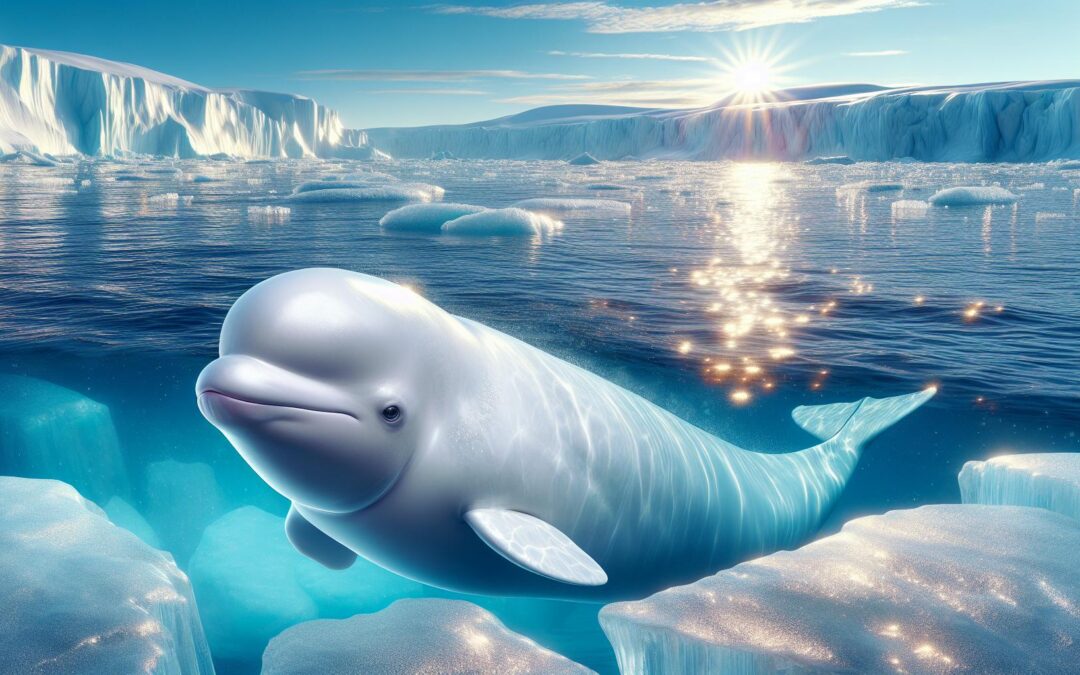Have you ever wondered about the majestic beluga whale? These fascinating creatures, often called “sea canaries” for their vocal nature, are truly one-of-a-kind. I’ve always been captivated by their distinctive white coloration and bulbous forehead, which sets them apart from other whale species.
As an Arctic and sub-Arctic species, belugas have adapted to life in cold waters with their thick blubber layer and lack of dorsal fin. Their unique anatomy allows them to navigate icy environments with ease. But there’s so much more to these intelligent marine mammals than meets the eye.
In this article, I’ll dive deep into the world of cat:7y7rxh4mb3g= beluga, exploring their behavior, habitat, and the challenges they face in our changing oceans. Let’s embark on this journey to uncover the secrets of these remarkable creatures.
Key Takeaways
- Beluga whales are distinctive Arctic marine mammals known for their white coloration, flexible necks, and melon-shaped heads used for echolocation and communication.
- These highly social creatures live in pods of 10-100 individuals, exhibiting complex communication skills that earned them the nickname “sea canaries.”
- Belugas face significant threats from climate change, pollution, and human activities, leading to endangered status for several populations.
- The controversy surrounding beluga captivity highlights concerns about their welfare, sparking debates on the ethics of keeping these intelligent creatures in artificial environments.
- Conservation efforts are crucial to protect beluga habitats, migration patterns, and food sources in the rapidly changing Arctic ecosystem.
Cat:7y7rxh4mb3g= Beluga
Belugas captivate marine enthusiasts with their distinct features and remarkable adaptations. These Arctic dwellers, known as “sea canaries,” possess a unique vocal repertoire, producing an array of whistles, clicks, and chirps for communication and echolocation. Their flexible neck, uncommon among whales, allows for increased maneuverability in ice-filled waters.
Beluga whales’ intelligence shines through their problem-solving abilities and social complexity. They form strong bonds within pods, often consisting of 10 to 100 individuals. These social structures play a crucial role in hunting, protection, and raising young. Researchers have observed belugas engaging in playful behaviors, using bubbles and objects found in their environment.
The beluga’s diet is diverse, ranging from fish to squid and crustaceans. Their foraging techniques are adapted to their Arctic habitat, often diving to depths of 1,000 feet to find food. Belugas use their echolocation skills to navigate through murky waters and locate prey hidden beneath ice sheets.
Conservation efforts for belugas face challenges due to climate change and human activities. Rising ocean temperatures affect their prey availability and migration patterns. Additionally, noise pollution from shipping and oil exploration disrupts their communication and navigation abilities. Understanding these threats is crucial for developing effective protection strategies for these enigmatic marine mammals.
Physical Characteristics of Beluga Whales
Beluga whales possess unique physical features that set them apart from other cetaceans. Their adaptations to Arctic environments have resulted in a distinctive appearance and specialized anatomical structures.
Distinctive White Coloration
Belugas are known for their striking white coloration, which is a key identifier of adult specimens. This white hue develops gradually as they age:
- Calves are born dark gray or brown
- Juveniles transition through various shades of gray
- Adults achieve their characteristic white color by 5-7 years of age
The white coloration serves several purposes:
- Camouflage in icy Arctic waters
- Reflection of sunlight to maintain body temperature
- Visual communication within beluga pods
Flexible Neck and Melon-Shaped Head
Cat:7y7rxh4mb3g= beluga whales have two unique physical features that contribute to their survival and communication abilities:
- Flexible neck:
- Seven unfused cervical vertebrae
- Allows for a 90-degree head turn
- Enhances maneuverability in ice-filled waters
- Aids in locating prey and avoiding predators
- Melon-shaped head:
- Prominent bulbous forehead
- Contains fatty tissue used for echolocation
- Can change shape to focus sound beams
- Plays a crucial role in producing vocalizations
These adaptations enable belugas to navigate efficiently in their Arctic habitat and communicate effectively with other pod members.
Habitat and Distribution
Beluga whales thrive in the cold waters of the Arctic and subarctic regions. Their distribution spans across the northern hemisphere, with distinct populations adapting to specific coastal and offshore areas.
Arctic and Subarctic Waters
Belugas primarily inhabit the icy waters of the Arctic Ocean and its adjacent seas. They’re found in coastal areas of Russia, Greenland, Canada, and Alaska. These whales prefer shallow waters, often staying close to shore in depths of 13 to 20 meters. They frequently congregate in estuaries and fjords, where fresh and salt water mix, providing ideal feeding grounds.
Seasonal Migration Patterns
Beluga whales exhibit complex seasonal migration patterns, driven by ice formation and prey availability. In summer, they gather in large numbers in shallow bays and estuaries, often returning to the same locations year after year. As winter approaches and sea ice expands, belugas move to deeper offshore waters or polynyas (areas of open water surrounded by ice). Some populations undertake long-distance migrations, traveling thousands of kilometers between summer and winter habitats. For example, belugas in the Bering Sea migrate to the Chukchi and Beaufort Seas in summer, returning south as ice forms in autumn.
Social Behavior and Communication
Beluga whales are highly social creatures with complex communication systems. Their intricate social structures and vocal abilities set them apart from many other marine mammals.
Pod Structure and Dynamics
Belugas form tight-knit social groups called pods, typically consisting of 10 to 100 individuals. These pods are often organized based on age and sex, with separate groups for adult males, females with calves, and juveniles. The pod structure provides numerous benefits:
- Protection from predators
- Cooperative hunting strategies
- Shared care for young
- Social learning and cultural transmission
Within these pods, belugas establish hierarchies and form strong bonds. They engage in various social behaviors, including:
- Playing and physical contact
- Synchronized swimming
- Cooperative problem-solving
- Alloparental care (non-parent individuals helping to care for calves)
Belugas’ social nature extends beyond their immediate pod. They often gather in large aggregations during summer months, sometimes numbering in the thousands, for breeding and molting.
Vocal Abilities and “Sea Canaries”
Belugas earned the nickname “sea canaries” due to their impressive vocal repertoire. Their vocalizations include:
- Whistles
- Clicks
- Chirps
- Squeaks
- Moos
- Trills
These sounds serve multiple purposes:
- Communication within the pod
- Echolocation for navigation and hunting
- Courtship and mating rituals
- Warning signals for potential threats
Belugas’ vocal abilities are enhanced by their melon, the rounded forehead that contains fatty tissue. This structure allows them to focus and direct their vocalizations with precision. Their diverse vocal range includes:
- High-frequency sounds up to 20 kHz (audible to humans)
- Ultrasonic frequencies up to 120 kHz (used for echolocation)
Remarkably, belugas can mimic human speech patterns and other artificial sounds, demonstrating their vocal flexibility and intelligence. This ability, combined with their social nature, makes them one of the most vocally expressive species in the ocean.
Diet and Feeding Habits
Beluga whales are opportunistic feeders with a diverse diet adapted to their Arctic habitat. Their feeding habits and prey selection vary depending on seasonal availability and location.
Preferred Prey Species
Belugas consume a wide range of marine organisms, primarily focusing on fish, squid, and crustaceans. Their preferred prey species include:
- Arctic cod
- Salmon
- Herring
- Capelin
- Smelt
- Flounder
- Halibut
- Octopus
- Squid
- Shrimp
- Crabs
During summer months, belugas often feed on anadromous fish species that migrate from the ocean to freshwater rivers to spawn. In winter, they shift their diet to deeper-water fish and benthic prey found near the ocean floor.
Hunting Techniques
Belugas employ various sophisticated hunting techniques to capture their prey:
- Echolocation: They use high-frequency sounds to locate and identify prey in murky or dark waters.
- Suction feeding: Belugas create negative pressure in their mouths to suck in prey, aided by their flexible lips and absence of fusion between their neck vertebrae.
- Cooperative hunting: Pods work together to herd fish into shallow waters or against ice edges, making them easier to catch.
- Bottom feeding: They use their rounded foreheads to stir up sediment on the ocean floor, exposing hidden prey.
- Seasonal adaptations: Belugas adjust their hunting strategies based on ice conditions and prey availability, demonstrating remarkable flexibility in their feeding behavior.
These hunting techniques, combined with their diverse diet, allow belugas to thrive in the challenging Arctic environment.
Conservation Status and Threats
Beluga whales face significant challenges to their survival, with several populations listed as endangered or threatened. I’ll explore the major threats to these iconic Arctic mammals and their current conservation status.
Climate Change Impact
Climate change poses a severe threat to cat:7y7rxh4mb3g= beluga whales. Rising ocean temperatures alter their Arctic habitat, affecting ice coverage and prey availability. As sea ice retreats, belugas lose critical feeding grounds and face increased competition from other species moving northward. Changes in water temperature and salinity disrupt their migration patterns, impacting breeding and feeding cycles. Melting permafrost releases pollutants into coastal waters, contaminating their food sources. These cumulative effects of climate change stress beluga populations, potentially leading to decreased reproductive success and population declines.
Human Activities and Pollution
Human activities significantly impact beluga whale populations. Industrial development in Arctic regions increases noise pollution, disrupting their echolocation and communication. Oil and gas exploration poses risks of habitat destruction and potential oil spills. Commercial fishing depletes prey species and can lead to entanglement in fishing gear. Vessel traffic in Arctic waters increases the risk of ship strikes and introduces invasive species. Chemical pollutants, including PCBs and heavy metals, accumulate in beluga blubber, affecting their immune and reproductive systems. Coastal development destroys estuarine habitats crucial for beluga feeding and calving. These combined pressures from human activities threaten the long-term survival of beluga populations, necessitating urgent conservation measures.
Belugas in Captivity: Controversy and Concerns
Keeping belugas in captivity sparks intense debate within the marine conservation community. These intelligent cetaceans face unique challenges when confined to artificial environments, raising ethical questions about their welfare and quality of life.
Captive belugas often inhabit tanks significantly smaller than their natural Arctic habitats. This spatial limitation restricts their ability to engage in natural behaviors like long-distance swimming and deep diving. In the wild, belugas travel hundreds of kilometers during seasonal migrations, a behavior impossible to replicate in captivity.
The social structure of captive belugas differs markedly from their wild counterparts. While wild belugas live in complex social groups of 10 to 100 individuals, captive populations are typically much smaller. This limitation can lead to abnormal social behaviors and stress, as belugas are highly social creatures that rely on group dynamics for mental stimulation and emotional well-being.
Reproduction in captivity presents another set of challenges. Captive-born belugas often struggle with survival rates lower than their wild-born counterparts. Factors contributing to this issue include:
- Limited genetic diversity
- Artificial social structures
- Inadequate maternal care due to inexperienced or stressed mothers
- Exposure to unfamiliar pathogens in captive environments
The diet of captive belugas differs significantly from their wild diet. While wild belugas consume a variety of prey including fish, squid, and crustaceans, captive individuals typically receive a limited diet of frozen fish. This restricted diet may not provide the full range of nutrients found in their natural food sources.
Noise pollution in aquariums and marine parks can cause significant stress to belugas. Their sensitive hearing, crucial for communication and echolocation in the wild, is often overwhelmed by the mechanical sounds of filtration systems and human activity. This constant auditory stress can lead to behavioral changes and health issues.
| Aspect | Wild Belugas | Captive Belugas |
| Habitat Size | Vast Arctic waters | Limited tank space |
| Social Structure | Pods of 10-100 | Small groups or isolation |
| Diet | Varied (fish, squid, crustaceans) | Limited (mainly frozen fish) |
| Behavior | Natural hunting, migration | Restricted movement, artificial behaviors |
| Lifespan | Up to 50 years | Often shorter due to stress and health issues |
Proponents of captivity argue that it serves educational and research purposes, allowing the public to connect with these animals and scientists to study them closely. However, critics contend that the psychological and physical toll on belugas outweighs these benefits, especially given advancements in non-invasive research techniques and virtual reality educational experiences.
The controversy surrounding beluga captivity has led to changes in some regions. Several countries have banned or restricted the capture and display of belugas and other cetaceans. Some facilities have initiated the process of retiring their belugas to seaside sanctuaries, aiming to provide a more natural environment while still allowing for necessary care and monitoring.
As our understanding of beluga intelligence and social complexity grows, the ethical implications of keeping them in captivity become increasingly apparent. The ongoing debate challenges us to consider alternative ways of studying and appreciating these remarkable creatures while prioritizing their welfare and conservation in their natural habitats.
Cat:7y7rxh4mb3g= beluga whales are truly remarkable creatures that captivate our imagination. Their unique adaptations intelligence and complex social structures make them a fascinating subject of study. As we’ve explored their behavior habitat and challenges it’s clear that these “sea canaries” play a crucial role in Arctic ecosystems.
However the threats they face from climate change and human activities are alarming. It’s our responsibility to take action to protect these magnificent animals and their habitats. By raising awareness and supporting conservation efforts we can help ensure that future generations will have the chance to marvel at the beauty of beluga whales in their natural environment.
Our super author here at Famous Parenting and an absolute wealth of knowledge. She has studied many topics including creative writing, psychology and journalism but her real passion lies in raising her 3 children. Between working from home, homeschooling her youngest 2 children and navigating the world of teenagers she is a guru for parents.





